In just under 2 weeks, I’ll leave for a 6 month backpacking trip in South America. I have spent the past 10 months studying Spanish and preparing physically, and I decided to test those skills in the real world. To get a taste of what backpacking in Latin America would be like, 2 friends and I took the bus from Austin to Monterrey for a few days. Due to work commitments, we could be away for 4 days, 2 of which were spent mostly on buses, giving us 2 days to explore.
About Monterrey
Monterrey is a city in the state of Nuevo León in Northern Mexico with about 5 million people living in its metro area. In addition to being the second largest metro area in Monterrey the city is also one of Mexico’s wealthiest. People living in Monterrey, or Regiomontanos as they call themselves, have the highest per-capita income in all of Mexico. This wealth is largely due to its industrial sector, which produces many products for use both in Mexico and the United States (1).
The city has strong US influence, with many in Latin America dubbing it “that gringo city.” And due to Monterrey’s largely industrial economy and heavy United States influence, it’s not as popular to visit as other Mexican cities like Cancún or Mexico City.
Map of Monterrey.
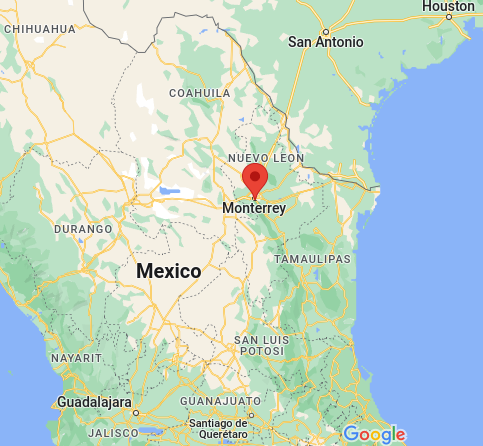
As I learned during my visit, it is still an awesome place. In addition to the many parks and outdoor spaces in the city, like Barrio Antiguo, la Macroplaza, and Parque Fundidora, there are also a number of hikes outside the city. Most of these hikes are in the Sierra Madre Oriental mountain range that runs just South and West of the city. These mountains are tall, steep, and forested, providing a cool, damp retreat from the hot, semi-arid climate of Monterrey.
Getting There
We left Austin on a via bus, and 10 hours later pulled up to the bus station in Monterrey. From the station, we took the metro to our hostel, My Family in Monterrey.
What We Did
We spent our first day in the city walking around the city and getting a feel for things. We went to Barrio Antiguo, Macroplaza, and Parque Fundidora. They were nice places to visit, especially Parque Fundidora.
Pictures from Parque Fundidora.
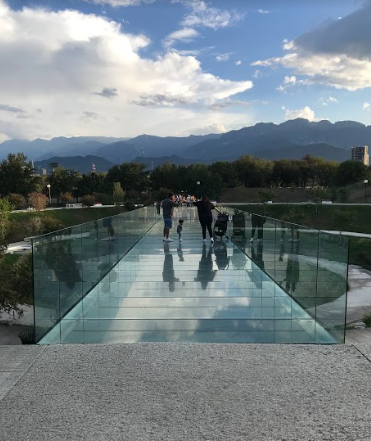
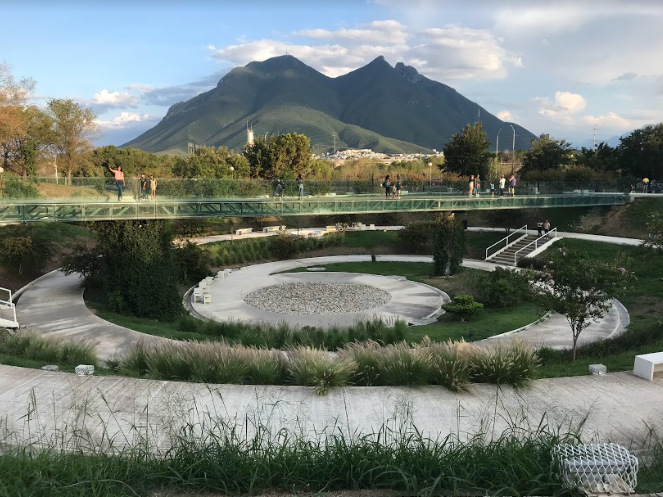
The second day, we left the city and took an Uber to Parque Ecológica Chipinque, one of the many parks in the mountains near Monterrey. In addition to Chipinque, there is also Parque Nacional Cumbres de Monterrey and Reserva Natural Estatal Sierra Las Mitras, to name a few. If I had more time, I could have easily spent weeks exploring the region’s many parks.
There are many reasons for the abundance of mountain preserves around the city. For one, the Sierra Madre Oriental is a biodiversity hotspot in Mexico, a country which is in turn a global biodiversity hotspot. In other words, over 12% of all species in the world can be found in Mexico, and a substantial number of those can be found in the Sierra Madre Oriental (2). Many of these species, like the maroon-fronted parrot, are very rare and can be found nowhere else in the world (3).
Rainfall in these mountains also supplies the majority of the city’s water (4, 5). The forests that grow in the mountains moderate the flow of water, limiting runoff during heavy rain and increasing it during drought. The importance of the forests in regulating the flow of water highlights the need to conserve them, as damaging the mountains’ ecosystems puts the entire city’s water supply in jeopardy (4).
We spent a few hours hiking up the mountains in Chipinque along with an Argentine we met at the hostel named Naicol. During the hike, Naicol kept referring to me and my 2 friends as pendejos.
¡Me pareció injusto! What did we do to receive such a mean title?
She explained that, while in most of Latin America pendejo is a grave insult, in Argentina, pendejos are just children. And since she was 25 and we were all 22, we were pendejos. The differing meanings of the word was something she learned the hard way; shortly after arriving in Mexico she drew the ire of many parents after greeting a group of schoolchildren by calling:
“¡Hola pendejos!”
As we switchbacked up the mountain, the shrubs of the lower elevations turned to tall pine and oak forests, one of the previously mentioned high-biodiversity environments in Mexico. Yet despite being the monsoon season, the soil was cracked and dry, with a number of dead fallen pine trees showing that the ongoing drought in Monterrey had impacted the mountains, too.
After many kilometers and many spirited conversations, we made it to two miradores, or lookouts. From the miradores, we could see the entire city on one side, and the tall mountain peaks on the other. Gringo city or not, the views were incredible.
View of the Sierra Madre Oriental from one of the miradors.

After a few obligatory photos, we began talking to the other people who were also enjoying the miradores. They were all Regiomontanos who were out for a morning hike. One of them, an older lady, told us she worked for the circo, or circus. The circo was in town and she would be performing tonight. She said we should go and see hang from her hair, alongside her husband who could hang from his teeth! It seemed like we just stumbled into some evening plans.
Despite how far we had climbed to get to the mirador, we were at best halfway to the peak. Since it was getting hot, we decided to head back. None of us were really looking forward to a long, hot hike down the mountain, so Naicol suggested we “hacer dedo” back to the hostel.
“Hacer dedo?” I had not learned that one in my Spanish lessons and had no idea what it meant, so naturally, I said yes.
While I watched the family of coatís that were foraging near the road, Naicol started talking to a family who had driven their truck up the mountain road to the mirador. After a few minutes, the family told us to hop in the back of their truck, as they were headed downtown. Apparently, “hacer dedo” meant hitchhiking!
Hacemos dedo back to town.
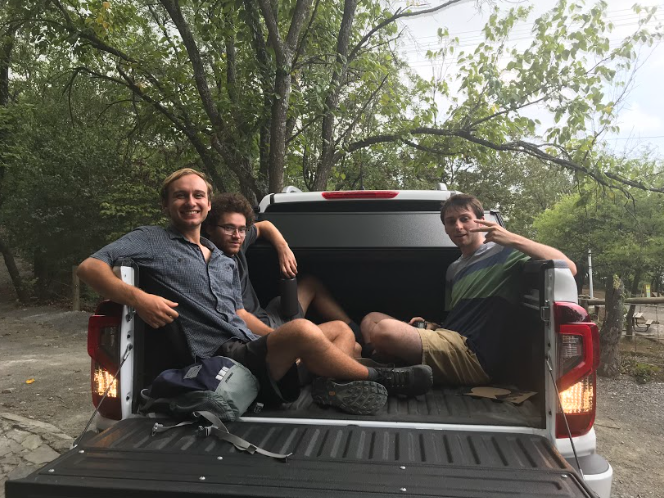
The family gave us a ride down the mountain, up a few miles of highway, and all the way to a part of downtown with many restaurants. Here, we asked to get out, and as we parted ways I thanked the nice couple and their adorable 9-month-old pendejo for the ride. Just a block from where we got out was a vegan taco shop called Revolución Verde, or Green Revolution. We are there, where I had some of the best tacos and lemonade of my life.
From there, we walked to the hostel to rest for a few hours before heading out to the circo. Eventually, the time came to go, only to find out on our arrival that the civil service had canceled the circo that night for reasons no one, not even the performers, fully understood.
Disappointed about the circo, we returned to the hostel to eat pizza and play cards. Someone from Monterrey suggested we play Uno, which I said was one of my favorite card games! Upon hearing my comment, he was surprised to hear that in the United States, Uno is not called One. I told him the cultural exchange goes both ways. After a few rounds of Uno, we went to sleep and the next day took the bus back to Austin.
Water Crisis in Monterrey
During my time in Monterrey, I heard a number of people talk about how nice it was to have water again. Like the deserts of the United States, Monterrey is in the midst of severe drought, and its severity has been compounded by a few factors. Logging in the Sierra Madre Oriental has reduced the flow of water from the mountains into the rivers during times of drought, and government corruption resulted in the cancelation of plans to build an additional reservoir for the city. The government was also very slow to reduce water supplies for many companies and wealthy neighborhoods earlier this year, squandering what little water was available. These problems reared their ugly head in June, when the city’s reservoirs basically ran out of water (6–8).
Satellite view of Monterrey’s Cerro Prieto Reservoir in July 2015 compared to July 2022 (9).
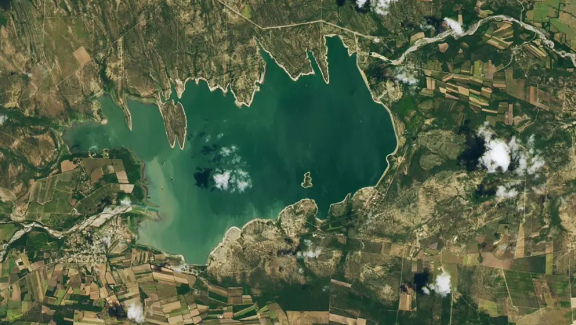

The city responded by cutting off running water to most of the area’s 5 million residents, forcing them to rely on water trucks arriving from outside the city. Despite living in one of Mexico’s wealthiest and most developed cities, many Regiomontanos were left without running water for months. Earlier this summer, many people had to wait in line for hours in the blistering heat just to get some water to drink. I was told the situation only relented when August brought much-needed rain, although the reservoirs remain very low.
The situation in Monterrey echoed what I had experienced in Austin in February 2021 during Winter Storm Urie and what happened in Jackson, Mississippi during my trip to Monterrey. In February 2021, most of Texas was without power or running water for a week after a record-breaking winter storm froze pipes and kept power plants from operating at full capacity (10–12). In Jackson, years of neglect to the city’s water system spelled disaster when record flooding inundated a water treatment plant, knocking it offline. The incident in Jackson cut off running water to all of the city’s 150,000 residents, and as of the time I published this article, the city is still without water (13, 14).
In all three of these cases, underinvestment in infrastructure and record weather events made possible by a changing climate converged to knock out basic utilities for weeks at a time. Such events are already common, and will likely grow more common in the future.
In Monterrey, there are many indications that prolonged heat and drought are the new normal. To adapt, the city will have to cut water use, increase water storage, and protect and restore the forests of the Sierra Madre Oriental (15). Protecting the Sierra Madre Oriental is especially important, since it is the source of most of the region’s water (4, 5). As a result, the health of the city is intertwined with the health of its forests. Or, as one promotional video for Chipinque put it:
“Conservarla [naturaleza] es conservarnos” (16).
Protecting the environment is protecting ourselves.
Sources
- M. Fadic, J. E. Garcilazo, A. M. Monroy, P. Veneri, “OECD Regions and Cities at a Glance” (Organization for Economic Cooperation and Development, 2019), , doi:10.1787/b902cc00-en.
- R. Modley, Protecting the biodiversity of the Sierra Madre Oriental. GIZ, (available at https://www.giz.de/en/worldwide/25056.html).
- S. G. Ortiz-Maciel, C. Hori-Ochoa, E. Enkerlin-Hoeflich, MAROON-FRONTED PARROT (RHYNCHOPSITTA TERRISI) BREEDING HOME RANGE AND HABITAT SELECTION IN THE NORTHERN SIERRA MADRE ORIENTAL, MEXICO. Wilson J. Ornithol. 122, 513–517 (2010).
- Fondo de Agua Monterrey Metropolitano de Monterrey. Latin American Water Funds Partnership, (available at https://www.fondosdeagua.org/content/dam/tnc/nature/en/documents/latin-america/Monterreye.pdf).
- S. E. O. Hernandez, Cumbres de Monterrey Biosphere Reserve, Mexico. UNESCO (2018), (available at https://en.unesco.org/biosphere/lac/cumbres-de-monterrey).
- L. Perlmutter, “It”s plunder’: Mexico desperate for water while drinks companies use billions of litres. The Guardian (2022), (available at https://amp.theguardian.com/global-development/2022/jul/28/water-is-the-real-thing-but-millions-of-mexicans-are-struggling-without-it).
- C. Rodriguez, M. Abi-Habib, B. Avelar, Mexico’s Cruel Drought: “Here You Have to Chase the Water.” The New York Times (2022), (available at https://www.nytimes.com/2022/08/03/world/americas/mexico-drought-monterrey-water.html).
- M. Radwin, Climate change hits northern Mexico, as officials look to solve water crisis. Mongabay Environmental News (2022), (available at https://news.mongabay.com/2022/08/climate-change-hits-northern-mexico-as-officials-look-to-solve-water-crisis/).
- S. Corona, Cerro Prieto: La NASA retrata desde el espacio la sequía extrema en Mexico. El País (2022), (available at https://elpais.com/mexico/2022-07-23/la-nasa-retrata-desde-el-espacio-la-sequia-extrema-en-mexico.html%20https:/elpais.com/mexico/2022-07-23/la-nasa-retrata-desde-el-espacio-la-sequia-extrema-en-mexico.html).
- J. Cohen, L. Agel, M. Barlow, C. I. Garfinkel, I. White, Linking Arctic variability and change with extreme winter weather in the United States. Science. 373, 1116–1121 (2021).
- M. Cai, E. Douglas, M. Ferman, How Texas’ power grid failed in 2021 — and who’s responsible for prev…. The Texas Tribune, (available at https://www.texastribune.org/2022/02/15/texas-power-grid-winter-storm-2021/).
- S. Spivey, K. Blake, A. Medina, Texas’ Big Freeze in 2021 through the lens of meteorologists — Whatever the Weather video podcast (2022), (available at https://www.ksat.com/weather/2022/02/08/texas-big-freeze-in-2021-through-the-lens-of-meteorologists-whatever-the-weather-video-podcast/).
- B. Dennis, S. Kaplan, Jackson, Miss., shows how extreme weather can trigger a clean-water crisis. The Washington Post (2022), (available at https://www.washingtonpost.com/climate-environment/2022/08/31/jackson-water-crisis-mississippi-floods/).
- T. Waldrop, Mom and son share videos of daily life with no clean water in Jackson, Mississippi. CNN (2022), (available at https://www.cnn.com/videos/us/2022/09/02/jackson-mississippi-water-crisis-mother-and-son-boil-water-orig-llr.cnn).
- E. Molina-Perez, D. G. Groves, S. W. Popper, R. Crespo-Elizondo, Developing a Robust Water Strategy for Monterrey, Mexico: Diversification and Adaptation for Coping with Climate, Economic, and Technological Uncertainties (RAND Corporation, 2019).
- P. E. Chipinque, Chipinque. Inixar, (available at https://www.inixar.com/proyectos/chipinque).